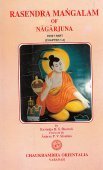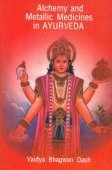Madhyamaka, Madhyamika, Madhyamikā, Mādhyamaka, Mādhyamika: 15 definitions
Introduction:
Madhyamaka means something in Buddhism, Pali, Hinduism, Sanskrit, Jainism, Prakrit, the history of ancient India, Hindi. If you want to know the exact meaning, history, etymology or English translation of this term then check out the descriptions on this page. Add your comment or reference to a book if you want to contribute to this summary article.
Alternative spellings of this word include Madhyamik.
In Hinduism
Jyotisha (astronomy and astrology)
Source: Wisdom Library: Brihat Samhita by VarahamihiraMādhyamika (माध्यमिक) refers to a country belonging to “Madhyadeśa (central division)” classified under the constellations of Kṛttikā, Rohiṇī and Mṛgaśīrṣa, according to the system of Kūrmavibhāga, according to the Bṛhatsaṃhitā (chapter 14), an encyclopedic Sanskrit work written by Varāhamihira mainly focusing on the science of ancient Indian astronomy astronomy (Jyotiṣa).—Accordingly, “The countries of the Earth beginning from the centre of Bhāratavarṣa and going round the east, south-east, south, etc., are divided into 9 divisions corresponding to the 27 lunar asterisms at the rate of 3 for each division and beginning from Kṛttikā. The constellations of Kṛttikā, Rohiṇī and Mṛgaśīrṣa represent the Madhyadeśa or central division consisting of the countries of [i.e., Mādhyamika] [...]”.

Jyotisha (ज्योतिष, jyotiṣa or jyotish) refers to ‘astronomy’ or “Vedic astrology” and represents the fifth of the six Vedangas (additional sciences to be studied along with the Vedas). Jyotisha concerns itself with the study and prediction of the movements of celestial bodies, in order to calculate the auspicious time for rituals and ceremonies.
In Buddhism
General definition (in Buddhism)
Source: archive.org: The Indian Buddhist Iconography (b)Madhyamaka (मध्यमक) refers to one of the schools of philosophy in Buddhism.—[...] Thus there were three Yānas in Buddhism about 300 A.D. which may approximately be taken as the time of Asaṅga. But against these three Yānas there were four schools of philosophy in Buddhism, namely, the Sarvāstivāda (Sautrāntika), the Vāhyārthabhaṅga (Vaibhāṣika), the Vijñānavāda (Yogācāra), and the Śūnyavāda (Madhyamaka). How these four systems of philosophy were distributed amongst the three Yānas is one of the vital questions of Buddhism.
According to the Tattvaratnāvalī of Advayavajra (12th century A. D.):—“three are the Yānas, Śrāvakayāna, Pratyekayāna and Mahāyāna. There are four theories; Vaibhāṣika, Sautrāntika, Yogācāra and Madhyamaka. Śrāvakayāna and Pratyekayāna are explained by the theories of the Vaibhāṣikas. Mahāyāna is of two kinds: Pāramitānaya and Mantranaya. Pāramitānaya is explained by the theories either of Sautrāntika, Yogācāra or Madhyamaka. Mantranaya is explained by the theories of Yogācāra and Madhyamaka only”.
In Jainism
Jain philosophy
Source: archive.org: Anekanta Jaya Pataka of Haribhadra SuriMādhyamika (माध्यमिक) refers to one of the four schools of Buddhism, as occurring in the Anekāntajayapatākā-prakaraṇa, a Śvetāmbara Jain philosophical work written by Haribhadra Sūri.—[Cf. Vol. I, P. 80, l 10]—Mādhyamika (or Śūnyavāda, Mādhyamikavāda, Nairātmyavāda) is the name of one of the four schools of Buddhism, the other three being (i) Sautrāntika, (ii) Vaibhāṣika (or Āryasamitīya or Sarvāstivāda) and (iii) Yogācāra (or Vijñānavāda). The Mādhyamika school domes reality of the ends, being (bhāva) and non-being (abhāva) and affirm it of the centre (madhya) only, which is neither being nor non-being but simply ‘śūnya’ or ‘emptyness’.
-
India history and geography
Source: archive.org: Geography in Ancient Indian inscriptionsMādhyamikā (माध्यमिका).—Barli Pillar inscription mentions an inhabitant of Majhimikā (Ski. Mādhyamikā). Majhimikā may safely correspond to modern Nagari in the Chitorgarh district in Rajasthan. The attribute śāli-mālinī in the Barli Pillar inscription possibly refers to the rice-fields that surrounded the town. At Mādhyamikā, as we find in the Mahābhārta, the people known as Vāṭadhanas had a settlement there.

The history of India traces the identification of countries, villages, towns and other regions of India, as well as mythology, zoology, royal dynasties, rulers, tribes, local festivities and traditions and regional languages. Ancient India enjoyed religious freedom and encourages the path of Dharma, a concept common to Buddhism, Hinduism, and Jainism.
Languages of India and abroad
Sanskrit dictionary
Source: DDSA: The practical Sanskrit-English dictionaryMadhyamaka (मध्यमक).—a. (-mikā f.)
1) Middle, middle-most.
2) Common (property &c.).
-kam The interior of anything.
--- OR ---
Madhyamikā (मध्यमिका).—A girl arrived at puberty, a marriageable woman.
--- OR ---
Mādhyamaka (माध्यमक).—a. (-mikā f.) [mādhyamika] a. (-kī f.) Middle, central.
-kāḥ (m. pl.)
1) Name of a people or their country in the central part of India.
2) Name of a Buddhist school; भगवत्पूज्यपादाश्च शुष्कतर्कपटूनमून् । आहुर्माध्यमिकान् भ्रान्तानचिन्त्येऽस्मिन् सदात्मनि (bhagavatpūjyapādāśca śuṣkatarkapaṭūnamūn | āhurmādhyamikān bhrāntānacintye'smin sadātmani) || Pañchadaśī 2.3.
See also (synonyms): mādhyamika.
Source: Cologne Digital Sanskrit Dictionaries: Edgerton Buddhist Hybrid Sanskrit DictionaryMadhyamaka (मध्यमक).—presumably = Mādhyamika, q.v., in °ka-ruci, one who favors the Māhārāṣṭrī school: kṛtir iyaṃ paṇ- ḍita-ma °rucer Dharmākaramateḥ Sādhanamālā 417.7 (colophon).
--- OR ---
Mādhyamika (माध्यमिक).—m., an adherent of the Buddhist school of this name: Mahāvyutpatti 5144. Cf. Madhyamaka (-ruci).
Source: Cologne Digital Sanskrit Dictionaries: Shabda-Sagara Sanskrit-English DictionaryMadhyamikā (मध्यमिका).—f.
(-kā) A girl arrived at puberty, one in whom menstruation has commenced. E. madhyamā, kan added, in the fem. form.
Source: Cologne Digital Sanskrit Dictionaries: Cappeller Sanskrit-English DictionaryMadhyamaka (मध्यमक).—[neuter] = madhya [neuter], kaṃ praviś enter.
--- OR ---
Mādhyamaka (माध्यमक).—([feminine] mikā) central.
--- OR ---
Mādhyamika (माध्यमिक).—[adjective] = [preceding]; [masculine] [plural] [Name] of a midland people.
Source: Cologne Digital Sanskrit Dictionaries: Monier-Williams Sanskrit-English Dictionary1) Madhyamaka (मध्यमक):—[from madhya] mf(ikā)n. middlemost, [Mṛcchakaṭikā]
2) [v.s. ...] common (as property), [Kātyāyana-śrauta-sūtra [Scholiast or Commentator]]
3) Madhyamikā (मध्यमिका):—[from madhyamaka > madhya] f. a marriageable woman, [cf. Lexicographers, esp. such as amarasiṃha, halāyudha, hemacandra, etc.]
4) [v.s. ...] Name of the 2nd or middle Grantha of the Kāṭhaka (cf. mādhyamika)
5) Madhyamaka (मध्यमक):—[from madhya] n. the interior of anything (kam pra-√viś, to enter), [Mṛcchakaṭikā]
6) Madhyamika (मध्यमिक):—[from madhya] [probably] [wrong reading] for mādhyamika q.v.
7) Mādhyamaka (माध्यमक):—[from mādhya] mf(ikā)n. ([from] madhyama) relating to the middle region (id est. the atmosphere), [Nirukta, by Yāska]
8) Mādhyamikā (माध्यमिका):—[from mādhyamaka > mādhya] f. Name of the middle portion of the Kāṭhaka.
9) Mādhyamika (माध्यमिक):—[from mādhya] mfn. ([from] madhyama) = madhyamaka, [Nirukta, by Yāska] (also applied to a kind of cloth, [Patañjali])
10) [v.s. ...] m. [plural] Name of a Buddhist school, [Monier-Williams’ Buddhism 157; 159]
11) [v.s. ...] m. of a people in central India, [Varāha-mihira’s Bṛhat-saṃhitā]
Source: Cologne Digital Sanskrit Dictionaries: Yates Sanskrit-English DictionaryMadhyamikā (मध्यमिका):—(kā) 1. f. A girl arrived at puberty, one in her courses.
[Sanskrit to German]
Sanskrit, also spelled संस्कृतम् (saṃskṛtam), is an ancient language of India commonly seen as the grandmother of the Indo-European language family (even English!). Closely allied with Prakrit and Pali, Sanskrit is more exhaustive in both grammar and terms and has the most extensive collection of literature in the world, greatly surpassing its sister-languages Greek and Latin.
Hindi dictionary
Source: DDSA: A practical Hindi-English dictionaryMādhyamika (माध्यमिक) [Also spelled madhyamik]:—(a) secondary; middle; intermediary; —[pāṣāṇa yuga] middle stone age; —[śikṣā] secondary education; —[pāṭhaśālā] secondary school.
...
Kannada-English dictionary
Source: Alar: Kannada-English corpusMādhyamika (ಮಾಧ್ಯಮಿಕ):—[adjective] intermediate or intervening; in between; middle.
--- OR ---
Mādhyamika (ಮಾಧ್ಯಮಿಕ):—
1) [noun] name of a branch of Buddhism.
2) [noun] a follower of this branch of Buddhism.
Kannada is a Dravidian language (as opposed to the Indo-European language family) mainly spoken in the southwestern region of India.
See also (Relevant definitions)
Starts with: Madhyamakaksha, Madhyamakalakara, Madhyamakalamkara, Madhyamakaloka, Madhyamakanda, Madhyamakaumudi, Madhyamakavatara, Madhyamakavritti.
Full-text (+93): Shunyavada, Madhyamikavritti, Madhyamakavritti, Madhyamakaloka, Madhyamakalamkara, Madhyamik, Nagarjuna, Shantarakshita, Matyamikan, Mattimikan, Madhyamikiya, Alatacakra, Ji Zang, Mattumikan, Prasannapada, Dharmakaramati, Majhimika, Candrakirti, Dvadashamukha Shastra, Samanvaharana.
Relevant text
Search found 61 books and stories containing Madhyamaka, Madhyamika, Mādhyamikā, Madhyamikā, Mādhyamaka, Mādhyamika; (plurals include: Madhyamakas, Madhyamikas, Mādhyamikās, Madhyamikās, Mādhyamakas, Mādhyamikas). You can also click to the full overview containing English textual excerpts. Below are direct links for the most relevant articles:
Brahma Sutras (Shankaracharya) (by George Thibaut)
II, 2, 18 < [Second Adhyāya, Second Pāda]
Second Adhyāya < [Introduction]
I, 1, 1 < [First Adhyāya, First Pāda]
Buddha-nature (as Depicted in the Lankavatara-sutra) (by Nguyen Dac Sy)
2.1. The Buddha-nature and Mādhyamaka < [Chapter 1 - Evolution of the Buddha-nature Concept]
1.1. Āryadeva and His Works < [Chapter 3 - The Laṅkāvatārasūtra and Hindu Philosophy]
2. Hindu Philosophical Systems (f) Vedānta < [Chapter 3 - The Laṅkāvatārasūtra and Hindu Philosophy]
Rig Veda (translation and commentary) (by H. H. Wilson)
Mahayana Buddhism and Early Advaita Vedanta (Study) (by Asokan N.)
Chapter 2.1 - Madhyamika Philosophy
Chapter 1.8 - Summary of this Chapter
Maha Prajnaparamita Sastra (by Gelongma Karma Migme Chödrön)
Appendix 9 - The first Madhyamika authors (Nāgārjuna, Āryadeva, Rāhulabhadra) < [Chapter XXXVI - The eight recollections (anusmṛti or anussati)]
III. Emptiness according to the Madhyamaka < [Note on emptiness (śūnyatā)]
Note (2): The Mahāyānist dharmatā < [Part 2 - Understanding dharmatā and its synonyms]
A History of Indian Philosophy Volume 2 (by Surendranath Dasgupta)
Part 19 - The Dialectic of Nāgārjuna and the Vedānta Dialectic < [Chapter XI - The Śaṅkara School of Vedānta (continued)]
Part 1 - The World-Appearance < [Chapter XI - The Śaṅkara School of Vedānta (continued)]
Part 14 - Did Logic Originate in the Discussions of Āyurveda Physicians < [Chapter XIII - Speculations in the Medical Schools]
Related products



